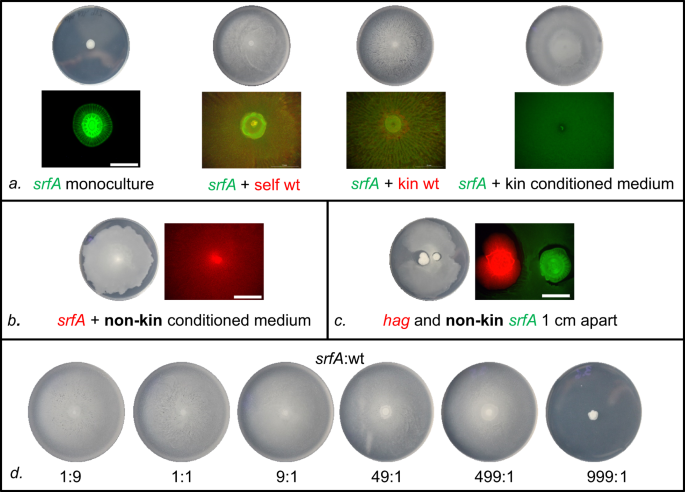By: Nayla Chapa
 |
| The srfA mutant with different types of strains that had been mixed with surfactin (PS-216) was conducted, with kin or nonkin in swarming agar. In part a, it contained the srfA by itself, mixed with PS-216 mKate which is the self combination, with PS-68 being the kin and lastly the conditioned medium contained 10 microliters from PS-216 mKate. In b the mutant contained the nonkin in a contained medium. In c hag and nonkin, srfA had a distance of 1cm, d is the swarming proportions at low proportion of wildtype. Figure taken from Kraigh et al. 2021. |
Microbes are an essential part of life. They are of great importance because they not only shape microbial communities but also biofilm or swarms. The role was to investigate whether B. subtilis soil happens to have kin discrimination in their community. Different types of strains were used, the focal strain which was PS-216, and its mix partners (PS-68 kin wildtype), along with srfA mutant were inoculated on swarming agar. The results showed that in the absence of srfA, PS-216 didn't seem to swarm, but when the strain (kin) was introduced it swarmed over the entire plate. In the figure, A contained srfA monoculture, srfA, and the self wildtype, srfA and kin wild-type and srfA with kin continued medium. The kin with the srfA as discussed worked best. In part, the srfA with nonkin conditioned medium was spread across the plate similar to kin since both are relatively similar and concluded that in order for the kin to discriminate against the nonkin a direct contact between both cells has to happen. They then tried to prove this by proceeding with C concluding that even in absence of the cell to cell contact the nonkin can share surfactant due to the hag mutant. D on the other hand concluded minor surfactant is needed for the populations to gain cooperative binding. Although surfactin did grow on the nonkin strain and was able to restore swarming of its surfactant, the territorial exclusion between that of nonkin as effective exploitation of public good. It was concluded that territorial exclusion only occurs among nonkin but not between kin. Overall more research should be conducted on whether the different types of methods using kin discrimination yield the same results, how can kin discrimination come to benefit and harm microbial activity as well.
Original Article:
Kraigher, B., Butolen, M., Stefanic, P., & Mulec, M. I. (2021). Kin discrimination drives territorial exclusion during Bacillus subtilis swarming and restrains exploitation of surfactin. ISME J. https://doi.org/10.1038/s41396-021-01124-4
Kraigher, B., Butolen, M., Stefanic, P., & Mulec, M. I. (2021). Kin discrimination drives territorial exclusion during Bacillus subtilis swarming and restrains exploitation of surfactin. ISME J. https://doi.org/10.1038/s41396-021-01124-4
No comments:
Post a Comment